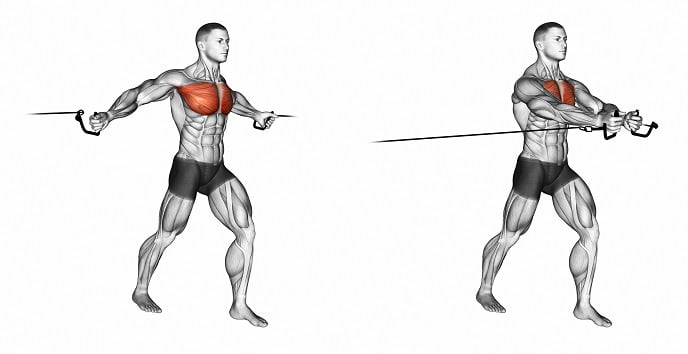Standing Cable Flys
4 SETS - 12 REPETITIONS
1. Set Up:
Begin by attaching two handles to the high pulleys of a cable crossover machine.
Adjust the pulleys to a height slightly above shoulder level.
2. Grip and Position:
Stand between the two pulleys, facing forward.
Hold one handle in each hand with an overhand grip, palms facing down.
Step forward slightly so that you feel a slight stretch in your chest muscles.
3. Starting Position:
Your arms should be extended forward, slightly below shoulder level.
Maintain a slight bend in your elbows throughout the movement.
4. Movement:
Inhale as you open your arms wide to the sides, creating a flying motion.
Keep your arms slightly bent and focus on using your chest muscles to move the handles.
5. Contraction:
Exhale as you bring the handles back together in front of you, crossing them at the center of your body.
Squeeze your chest muscles at the midpoint of the movement to maximize muscle engagement.
6. Range of Motion:
Avoid allowing the weight stack to touch or rest at the top. Maintain tension on your chest muscles.
7. Finish:
Once you’ve completed your set, gently release the handles and step back from the cable machine.

Tips for Proper Standing Cable Flys Form:
Controlled Movements: Perform the exercise in a controlled manner to avoid using momentum.
Focus on Chest: Concentrate on using your chest muscles to move the handles, rather than relying on your arms.
Proper Hand Position: Position your hands so that they’re at shoulder level when fully extended.
Breathing: Inhale as you open your arms, and exhale as you bring the handles together.
Steady Tempo: Maintain a steady and deliberate tempo throughout the exercise.
Warm-Up: Start with lighter weights as a warm-up to prepare your chest muscles.
Proper Setup: Adjust the pulley height and handle positioning to match your body size and comfort.
Range of Motion: Open your arms wide enough to feel a stretch in your chest but avoid overstretching or straining.
Mind-Muscle Connection: Focus on feeling the contraction in your chest muscles at the midpoint of the movement.
